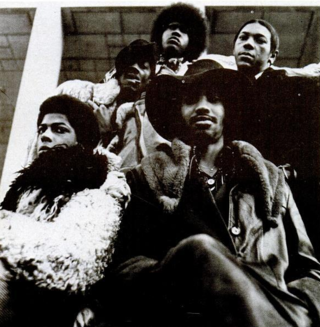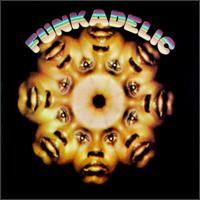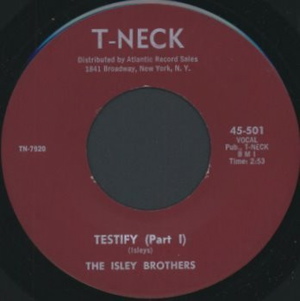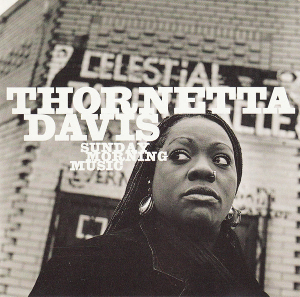
Funk is a music genre that originated in African-American communities in the mid-1960s when musicians created a rhythmic, danceable new form of music through a mixture of various music genres that were popular among African-Americans in the mid-20th century. It deemphasizes melody and chord progressions and focuses on a strong rhythmic groove of a bassline played by an electric bassist and a drum part played by a percussionist, often at slower tempos than other popular music. Funk typically consists of a complex percussive groove with rhythm instruments playing interlocking grooves that create a "hypnotic" and "danceable" feel. It uses the same richly colored extended chords found in bebop jazz, such as minor chords with added sevenths and elevenths, and dominant seventh chords with altered ninths and thirteenths.

Funkadelic was an American funk rock band formed in Plainfield, New Jersey in 1968 and active until 1982. As one of the two flagship groups of George Clinton's P-Funk collective, they helped pioneer the funk music culture of the 1970s. Funkadelic initially formed as a backing band for Clinton's vocal group the Parliaments, but eventually pursued a heavier, psychedelic rock-oriented sound in their own recordings. They released acclaimed albums such as Maggot Brain (1971) and One Nation Under a Groove (1978).

Edward Earl Hazel was an American guitarist and singer in early funk music who played lead guitar with Parliament-Funkadelic. Hazel was a posthumous inductee to the Rock and Roll Hall of Fame, inducted in 1997 with fifteen other members of Parliament-Funkadelic. His ten-minute guitar solo in the Funkadelic song "Maggot Brain" is hailed as "one of the greatest solos of all time on any instrument". In 2023, Rolling Stone ranked Hazel at no. 29 in its list of 250 of the greatest guitarists of all time.

Maggot Brain is the third studio album by the American funk rock band Funkadelic, released by Westbound Records in July 1971. It was produced by bandleader George Clinton and recorded at United Sound Systems in Detroit during late 1970 and early 1971. The album was the final LP recorded by the original Funkadelic lineup; after its release, founding members Tawl Ross (guitar), Billy Nelson (bass), and Tiki Fulwood (drums) left the band for various reasons.

William Earl "Bootsy" Collins is an American bass guitarist, singer-songwriter, and record producer.

Funkadelic is the debut album by the American funk rock band Funkadelic, released in 1970 on Westbound Records.
"Little Wing" is a song written by Jimi Hendrix and recorded by the Jimi Hendrix Experience in 1967. It is a slower tempo, rhythm and blues-inspired ballad featuring Hendrix's vocal and guitar with recording studio effects accompanied by bass, drums, and glockenspiel. Lyrically, it is one of several of his songs that reference an idealized feminine or guardian angel-like figure. At about two and a half minutes in length, it is one of his most concise and melodically focused pieces.

"Superstition" is a song by American singer-songwriter Stevie Wonder. It was released on October 24, 1972, as the lead single from his fifteenth studio album, Talking Book (1972), by Tamla. The lyrics describe popular superstitions and their negative effects.

Band of Gypsys is a live album by Jimi Hendrix and the first without his original group, the Jimi Hendrix Experience. It was recorded on January 1, 1970, at the Fillmore East in New York City with Billy Cox on bass and Buddy Miles on drums, frequently referred to as the Band of Gypsys. The album mixes funk and rhythm and blues elements with hard rock and jamming, an approach which later became the basis of funk rock. It contains previously unreleased songs and was the last full-length Hendrix album released before his death six months later.

John Watson Jr., known professionally as Johnny "Guitar" Watson, was an American musician. A flamboyant showman and electric guitarist in the style of T-Bone Walker, his recording career spanned forty years, and encompassed rhythm and blues, funk and soul music.

"That Lady" is a song by the Isley Brothers, made famous in 1973 when it was reworked in a funk rock style. It was originally performed as "Who's That Lady?" in a classic R&B vocal style by the Isley Brothers in 1964, inspired by the Impressions.

George Allen "Buddy" Miles Jr. was an American composer, drummer, guitarist, vocalist and producer. He was a founding member of the Electric Flag (1967), a member of Jimi Hendrix's Band of Gypsys (1969–1970), founder and leader of the Buddy Miles Express and later, the Buddy Miles Band. Miles also played and recorded with Carlos Santana and others. He also sang lead vocals on the California Raisins claymation TV commercials and recorded two California Raisins R&B albums.

Stevie Salas is an American guitarist, author, television host, music director, record producer, film composer, and former advisor of contemporary music at the Smithsonian National Museum of the American Indian. Salas was born on November 17, 1964, in Oceanside, California, United States.
Funk rock is a fusion genre that mixes elements of funk and rock. James Brown and others declared that Little Richard and his mid-1950s road band, the Upsetters, were the first to put the funk in the rock and roll beat, with a biographer stating that their music "spark[ed] the musical transition from fifties rock and roll to sixties funk".

"Testify" is an uptempo soul song by the American rhythm and blues group the Isley Brothers. Written by the Isleys and recorded in 1964, it followed several successful singles by the group and was the first single to appear on their own T-Neck record label.

The Way It Is is a studio album by former Deep Purple, Black Sabbath and Trapeze vocalist/ bassist Glenn Hughes. It was released in 1999 on Nippon Crown, SPV and Shrapnel Records and was Hughes’ sixth solo studio album.
The Soul to Soul Tour was a concert tour through North America, Europe and Australasia, undertaken by American blues rock band Stevie Ray Vaughan and Double Trouble from 1985 through 1986. At the beginning of the tour, the band had finished recording their album Soul to Soul. Their commercial and critical acclaim had been demonstrated during the Couldn't Stand the Weather Tour in 1984, when they had played before a sold-out audience at Carnegie Hall. Longing for opportunities to expand the group's lineup, Vaughan and Double Trouble hired keyboardist Reese Wynans during the Soul to Soul recording sessions in Dallas, Texas. Throughout the tour, the band's success was confirmed as their performances consistently amazed and gratified their audiences.

Dancin' on Coals is the second album by American hard rock band Bang Tango, released in 1991. It peaked at No. 113 on the Billboard 200. A single, "Untied and True", was a minor hit. Bang Tango supported the album by opening for Cheap Trick on a North American tour.

Don't Let the Bossman Get You Down! is an album by the American blues rock musician Elvin Bishop, released in 1991.

Sunday Morning Music is the debut album by the American blues rock singer Thornetta Davis, released in 1996. Davis was the first Black artist signed to Sub Pop, a label initially known for its grunge releases.

















